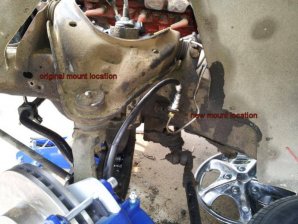Excellent and very useful post. Some issues mentioned:
1. The hoses might route better per factory design, with the brake hose coming up from the bottom into the frame bracket. Search for photos.
2. Which master cylinder you use is a personal choice. Your original drum-drum would actually work. A smaller bore makes an easier pedal but more travel. You don't want to risk bottoming out and disk calipers require more volume than drum cylinders. According to rockauto, my 65 Newport used a 1" bore for either manual or power brakes. They don't say if disk or drum. With 1-1/8" bore, you might need both feet to lock up the wheels with front disks if you lose the boost. The main difference is that disk MC's have a larger reservoir for the front disks (on aft end). I prefer the later 2-bolt aluminum MC's (see my recent post).
3. You do need a proportioning valve in series with the rear brake tube. The Summit one you show is fine. I bought others recently for ~$25 on ebay. You should mount it after your distribution/imbalance warning block, even though down in the mud. Adjust it so the fronts barely lock up first on a wet parking lot (use a helper). Without it, your rears will lock first which can make you spin out. Watch George Clooney do that on purpose using the parking brake in the movie The American.
4. The rubber bushing shown is usually only for manual MC's. Most say it keeps the rod from coming out, but I don't see how that could happen. I suspect it just stops rattling noise. The pedal rod on my 65 w/ power brakes has a groove on the end, but I found no rubber. Perhaps it was the same PN for manual brakes.
5. Below is a rockauto photo of a Midland-Ross booster. I have 2 and they look the same. I wondered what the white plastic trapezoid was for. I see no filter, but perhaps it fell out. I don't think air flows into the booster from the engine compartment, but it does slosh in and out as it moves. The vent is on the cabin side. When the pedal moves in, it opens a valve to leak air into the cabin side which pushes the piston forward into the MC. The spring in the MC returns it. That is my understanding how it works. I prefer the Midland-Ross booster since easy to take apart, though you won't find parts to rebuild one.



 OK. Trying not to die. Re located entire mount to other side of upper arm. The stock location is in front of the arm. when it only had drum brakes, the connection at the wheel is in the middle, so it was no big deal. with the ECI kit / with calipers, the calipers are at the rear of the wheel well, and the stock mount is at the front.
OK. Trying not to die. Re located entire mount to other side of upper arm. The stock location is in front of the arm. when it only had drum brakes, the connection at the wheel is in the middle, so it was no big deal. with the ECI kit / with calipers, the calipers are at the rear of the wheel well, and the stock mount is at the front.